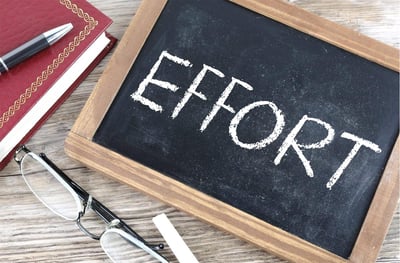Get Back on Track: 7 Strategies That Actually Works
Have you spent several days, weeks, or months painstakingly building a habit (maybe around writing) every day, and then suddenly you slipped up?
Life happened.
A couple of days went by.
And you didn't write a word.
And you felt deflated. You threw your hands up in the air and thought that all the hard work you put in to build the habit was wasted.
This all-or-nothing approach to habit creation is toxic and it happens to most of us.
I've lost count of the number of times I've been excited by a vision for my future, committed to a habit, executed it faithfully for a period of time, and then ... bang!
I missed a day because ... well ... life happened.
And then I've thrown my hands up in the air and let go of the habit completely!
On some level, I judged myself harshly for having slipped up (once) and then proceeded to punish myself by diving deeper into the crisis, knowing perfectly well that I'd have to face the consequences of this impulsive behavior later.
But it doesn't have to play out that way.
Here's the truth:
Everyone slips up from time to time.
Slipping up doesn't mean we're a failure though. It just means we're human.
The most successful people get back on track quickly. (A great way to do this is to set yourself up in the right environment. More on this later.)
Here are some tips to get back on track:
1. Get enough sleep

Lack of sleep has become endemic in our culture. According to the U.S. Centers for Disease Control and Prevention 30 percent, or 40.6 million, of American adults are sleeping six hours or less every day.
The ping of our smartphones has a lot to do with poor sleep patterns. Most of us require at least 7 hours of sleep so the brain can do its 'housecleaning' and 'reset' itself for the next day.
Not having adequate sleep results in sleep deficits and impacts almost every area of our lives including our moods, decision-making abilities, and our circadian rhythms.
Sleeping less than 6 hours increases your chances of stroke or heart disease. Less than six hours per night of sleep means a 48% greater chance of developing heart disease, and a 15% greater chance of a stroke.
These are grim statistics but worth paying attention to because it's so easy to address them. Getting at least 7 hours of sleep each night has a positive impact on so many areas of our lives and is the first step towards getting back on track.
Action steps:
- Set up a wind-down routine starting about two hours before bed where you don't engage with devices or work-related material.
- Reflect on the day while journaling and think about what went well and what didn't.
- Plan tomorrow today.
2. Use timeboxing to your advantage

One of my mentors once told me, "If it's not on my calendar, it doesn't get done".
It's been said that we have a tendency to overestimate what we can achieve in a day and underestimate what we can achieve in a year.
The problem with overestimating what we can achieve in a day is that it leads to disappointment, which then derails our progress towards our yearly goals.
A simple way to solve this is to allocate specific amounts of time to each task on your calendar and work towards getting things done within those timeframes.
Make sure you work some breaks into your schedule too. They're important.
I use an application called Sunsama which is outstanding in this regard.
It includes planning capabilities (for the day and the week), incorporates calendar appointments, and also allows you to look back on the previous day and/or week and learn from your past choices.
In my conversation, with James Clear, we talked about the importance of deciding on a specific time and place where you will do the thing you've committed to doing each day (your habit).
Scheduling it into your calendar helps you achieve this.
Being a little rigid about this one routine (showing up at the time and place you made a commitment to doing when you decided on the habit) is a great way to keep yourself on track or to get back on track.
Showing up should happen regardless of whether you showed up the previous day (or week, or month).
Action steps:
- When you're planning for tomorrow, make a conscious choice to include your habit in tomorrow's plan (yes the one you missed). Put down the time and the place where you'll do it.
- Notice any feelings of guilt or discomfort that arise in your body (I often feel a combination of guilt for having missed my habit. My all-or-nothing self also resists picking up the habit after having missed a day or more. That part of myself wants to throw it all away.)
- Sit with the feeling and observe the sensations in your body until they dissipate.
- Congratulate yourself and move on.
3. Show up in small ways and acknowledge every effort regardless of how small

Further to the previous point, one of the biggest demotivators is all-or-nothing thinking. When we fail to show up for one day we have a tendency to think that "all is lost".
I've observed this tendency in myself and a lot of people I've worked with over the years.
A great way to offset this all-or-nothing thinking is to acknowledge every single effort you make to show up. The acknowledgment of each little effort breaks the destructive all-or-nothing thinking patterns.
It works in a similar way to practicing gratitude.
My recommendation is to write down one way in which you showed up as part of your daily journaling habit.
It's also nice to go back and read about times you showed up in the past.
Self-efficacy is a big factor when it comes to motivation and this practice helps you build it.
Action steps:
- Write down three things you're grateful for.
- Make sure one of those three things about how you showed up. e.g. you wrote one sentence in your journal. Or you did one push-up.
4. Use your tribal instincts to your advantage

In my conversation with Noah Kagan, he talked a lot about accountability.
In an attempt to hold me accountable, Noah threw down a challenge that involved me agreeing to pay Noah $1000 if I didn't publish my Premium Productivity Course (which I'd been procrastinating for a while).
It worked!
I published the course within the agreed time.
While this approach did work, I'm not a big fan of the punitive aspect.
Personally, I prefer to have an accountability partner to whom I've made a commitment. Much like you would if you were to hire a personal trainer.
As far as our tribal instincts are concerned, the human brain hasn't changed significantly in 50,000 years.
This approach focuses on the positive aspects of our tribal instincts. It leverages human connection and exploits the positive aspects of connection.
I believe we're hard-wired to be accountable to other humans (the tribe) and that's why this approach works so well.
Accountability is something we're big on within the Productive Insights Membership community.
Action step:
- Reach out to someone you trust and ask them if they're ok with you checking in with them each day. Knowing you have to report to them massively increases the likelihood of you doing the thing. (As I write this blog post, I have a commitment to send my friend Andrea a list of things I'm grateful for each day.) Be sure to reciprocate in some way. Offering reciprocal accountability is perfect.
5. Get clear on your underlying narrative (story)
 I believe we all have a story that we tell ourselves. The script is often subconscious. We're not always conscious of the actual story, but it manifests in various ways.
I believe we all have a story that we tell ourselves. The script is often subconscious. We're not always conscious of the actual story, but it manifests in various ways.
I often feel a sense of dread when I email my subscribers. When I stop to examine the feeling and what's driving it, I become aware of the story that I'm telling myself (subconsciously) that I'm a fraud and I'm going to get found out.
Imposter syndrome is alive and well within me. In fact, it seems to be one of my specialties!
The thing is, I don't become aware of that narrative (of being a fraud) unless I pause and reflect on the feeling of dread and think about where it's coming from.
Often I find that when I sit down to write about it (much like I'm doing now) the story 'reveals' itself to me.
This is one of the many reasons journaling is a very valuable practice.
As it turns out, my underlying narrative is also often the reason I fall off the wagon.
For example, I don't stick to my commitment of emailing my list weekly, because the feeling of dread creeps in every time I sit down to write that email.
And unless I examine the feeling and follow the thread back to its source, I don't discover that story I'm telling myself about being an imposter.
Getting clear on your underlying narrative can be very helpful in getting you back on track and even staying on track with your habits.
Action steps:
- Get clear on your underlying narrative. What's the story you tell yourself (subconsciously)? This may not be apparent right away but asking yourself the question, and listening carefully to the self-talk (and the subtext) will reveal a lot over time.
- Choose a different narrative. This may mean reframing your story or adopting an alter ego. Check out this conversation with Todd Herman — author of The Alter Ego effect. He explains it beautifully. (Scroll down the page for the video conversation). Todd's book — the Alter Ego Effect — is outstanding. I recommend the audio version.
6. Cultivate a habit of making conscious choices in each present moment
 Following on from the previous point, it pays to make deliberate choices. Focusing on the fact that we can make choices (for the most part) in each present moment, is a great way to create a sense of agency.
Following on from the previous point, it pays to make deliberate choices. Focusing on the fact that we can make choices (for the most part) in each present moment, is a great way to create a sense of agency.
Examining the underlying narrative as a practice unlocks a lot of power because it releases us from having to suppress unhelpful narratives that are holding us back.
This means we have more emotional bandwidth and are better placed to make proactive choices in the present moment.
I think the two practices — becoming aware of your underlying story, and making conscious choices in each present moment — go hand in hand.
Having a visual cue to remind yourself that you have the power to make choices in each present moment — no matter how small they are — is a great way to make more of those choices and exercise that power.
Action steps:
- Check out the book Your Erroneous zones by Wayne Dyer. He talks about the importance of living fully in each present moment and about making choices in each moment.
- Start engaging fully in each moment. Give yourself completely to what you're doing and do so with passion and awareness. You'll start to become aware of how much agency (and choice) you have in each moment, and you'll get into flow states more easily.
7. Organize your (physical and digital) environment

Last but definitely not least, set yourself up for success by being meticulous about your environment. As James Clear explains so eloquently in his book — Atomic Habits — we tend to overestimate our capabilities when it comes to exercising willpower and self-discipline to stay on track.
The truth is, our environment has a lot more to do with our success and it's quite simply the easier option. As James said to me in this conversation on YouTube:
If you want to watch less TV don't have your lounge facing the television
The same goes for most aspects of our environment. Having a decluttered desk (this is something I'm still working on) can massively reduce anxiety and low-level stress which builds up over time.
Having a clean desk helps to think more clearly, and make better decisions.
Changing your iPhone to greyscale reduces its attractiveness and that means you're less likely to pick it up to get a dopamine hit the next time you're bored.
Action steps:
- Put down an action item in your calendar to clean your desk at the end of each day. It's a great way to wind yourself down and welcome your future self back to your desk.
- Change your phone to greyscale using these steps (these are the steps at the time of writing this post)
Links Mentioned:
- Episode 175 with James Clear — author of Atomic Habits:
https://www.productiveinsights.com/podcast/james-clear-atomic-habits
- Episode 176 with Todd Herman Author of Alter Ego Effect:
https://www.productiveinsights.com/podcast/todd-herman-alter-ego-effect
- Episode 147 with Noah Kagan -- How to Push Past Your Comfort Zone
https://www.productiveinsights.com/podcast/noah-kagan
- Productive Insights Membership
https://www.productiveinsights.com/membership
- Learn more about Pomodoro Technique
Ash Roy Video Transcript (This transcript has been auto-generated. Artificial Intelligence is still in the process of perfecting itself. There may be some errors in transcription)
Ash Roy:
To get back on track with your goals and your habits, seven strategies that actually work, that's what we're going to be talking about in this episode. Let me ask you something, have you spent days, weeks, or months, carefully cultivating a habit that's going to lead you to a certain goal? And then you've suddenly slipped up? Maybe you were planning on writing a book, and you wrote every single day, 300 words every day for about two months. And then life happened. And you missed today? Has that happened to you? Did you throw your hands up in the air and just say, Okay, that's it, I'm done, I'm never going to write that book? Because that's happened to me more times than I care to admit. And I'm here to tell you that you're not alone. It happens to almost all of us. In fact, I can't think of anyone it hasn't happened to.
But you know, the people that are most successful, they are not the kind of people who never miss a day, they are really good at getting back on the horse. After they've missed one day. And staying with the habit over the long term. They tend to be great at understanding that this is a marathon and not a sprint. So in this episode, I'm going to share with you seven strategies that actually work when it comes to building habits that are sustainable and help you to achieve your goals. Are you ready, strategy number one, get enough sleep. According to the US Center for Disease Control, and prevention. 30% or 40 point 6 million Americans sleep for six hours or less a day. The ping of our smartphones has a lot to do with these poor sleep patterns. Most of us require at least seven hours of sleep to have our brains function and for us to be performing in the most efficient manner we can. See the brain does a lot of housecleaning when you're asleep. Poor sleep impacts almost every area of our lives, including moods, our memory, our capacity to think clearly, and the list goes on. It even increases our risk of getting strokes and heart disease.
So here are three action steps you can take to set yourself up for a good night's sleep. Set up a wind-down routine, about two hours before you'd go to bed where you engage minimally with devices. This reduces exposure to something called blue light, which can affect your sleep patterns and your circadian rhythms. Step two, reflect on how your day was. While you're journaling. Towards the end of the day. This helps you to debrief yourself and to unwind the knots that can potentially come back to haunt you while you're trying to fall asleep. It allows you to put a nice bow on everything that happened in the day and put it to bed, no pun intended, so that you can prepare yourself for the next day and lead on from that plan the next day, the night before after you have finished your review. That way you go to bed, knowing what you're going to be working on and what the biggest and most important things you want to achieve the next day. And then your subconscious can work on it as you sleep. Okay, strategy number two, use time boxing to your advantage. One of my mentors once told me, that if it's not on your calendar, it's not going to happen.
Now, obviously, that's not 100% True. But I think what he was trying to say was to put everything that you need to do in your calendar and set time boxes. And that way you know what you need to be doing at a specific time. What that also does is reduce the likelihood that you overestimate what you can achieve in one day. It's believed that Bill Gates once said, most of us overestimate what we can achieve in one day and underestimate what we can achieve in 10 years. So one way to get around that is to put it in your calendar. Now one quick tip, make sure you weave in a few breaks between your work sprints as well. And we do this in our productive insights membership program where we actually have sprints together where we work in 25-minute increments, you can do that yourself, set up the Pomodoro Technique, you can head over to productive insights.com forward slash 190 to get a proper rundown on the Pomodoro Technique and how you can apply it in your life or business. Now in my conversation with James Clear in Episode 175, we talked about the importance of setting a specific time and place where you are going to complete your habit.
So the time boxing method fits in really well with implementing this particular approach that James Clear suggested and this is more likely to make sure that you get back on track even after you've fallen off the wagon as it were in terms of sticking to your habit and accomplishing your goal. Okay, so here are the action steps for strategy number two, which is time boxing. When you're planning for tomorrow. Make sure you include all your habits including the one you may have missed yesterday into your schedule and time box Each of them on your calendar, I want you to also put down the place where you'll do it. So when you commit to a time and a place where you will complete the habit, you are more likely to get back on track and achieve your goals. And as you're doing this time boxing, and you're planning for the next day, you may notice feelings of guilt or regret coming up, because you missed your habit yesterday, I want you to notice these feelings as sensations in your body and sit with them, and watch them until they dissipate. It's important to go through this process because it is a way to come to terms with missing out on a habit, but not throwing out the baby with the proverbial bathwater.
And staying with the marathon in the long term. Do you know what I mean? I often notice when I consciously pay attention to any feelings of guilt or regret that come up, and they do very often when I'm going through this debriefing session, at the end of the day and planning for the next day, I noticed that if I'm able to sit with them, sometimes I journal about them, I find that I'm able to come to terms with the process of sometimes slipping up, but not letting go of the whole marathon. Okay, strategy number three, show up in small ways and acknowledge every effort regardless of how small further to my previous point, one of the biggest D motivators is all or nothing thinking, you know, where you feel like you missed one day, and you just throw your hands up in the air, and you've abandoned the whole process. I've observed this all-or-nothing thinking and myself and a lot of people I've worked with over the years, it's far more common than you probably realize. And a great way to overcome this all-or-nothing thinking is to acknowledge and give yourself credit for when you show up. Because those little acknowledgments add up over time, it actually works in a pretty similar way to practicing gratitude. My recommendation is to journal every day, if possible, and write down what you achieved and how you showed up on that day, and congratulate yourself for your little victories because there are plenty of those that happen in the day.
And we often don't acknowledge them enough, we tend to only look at the things we missed out on, or we didn't do well. And that isn't very constructive. You see, self-efficacy is a really big deal when it comes to building your confidence and sustaining behaviors over the long term. And acknowledging your successes helps you build that self-efficacy. It's one of the strongest motivators we have access to. Okay, so action steps, write down three things you're grateful for every day, and make sure one of those three things is how you showed up in a little way today, that will help you get towards your long-term goal. It doesn't matter how little maybe you wrote one sentence in your journal, maybe you wrote a word, maybe you were kind to somebody, you didn't want to be kind to acknowledge every little bit that you've put into your day, that will help you over the long term. Okay, strategy number four, use your tribal instincts to your advantage. We are social creatures, and something that we are hardwired to do is to not let each other down wasn't until relatively recently, in the scheme of things that we were running around in tribes. And for us to survive, we have to be in good standing with the tribe and our brains and our neural systems have developed around that imperative. So a great way to get back on track with your habits, if you've fallen off the wagon is to use your tribal instincts to use accountability to get other people in your community or your tribe to keep you focused on the long-term goal. In episode 147. I spoke to Noah Kagan about various things. And one of the things I talked about was this course that I had been procrastinating on. And no, I held my feet to the fire. And he said, How about we make a deal if you don't publish that course, in a certain period of time, you have to give me $1,000. Now, I didn't want to pay $1,000 for procrastinating, and guess what, I published the course it was called a premium productivity course. And for a little, while I sold it for 497 US dollars, you could buy it standalone, but now it's only available inside the productive insights membership program, which you can find out more about at productive insights.com/membership.
Now, while this approach did work with Noah, it's not something that I'm a big fan of, you know, when you look at the carrot and the stick approach, I'm not a big fan of the stick. I prefer the carrot the incentivizing aspect of getting people to be accountable. And this is why I think having an accountability partner on an ongoing basis is a great thing. So for example, you often see people tend to get accountability partners when they go to the gym. Sometimes it's in the form of a coach, a fitness coach, to who they're paying money and if the fitness coach sees that they haven't shown up at a certain time that has been agreed upon, they'll give you a call or they'll SMSU. So that's a positive accountability agreement, I have a goal with one of my colleagues where I have to publish a newsletter every week. So far, it's been working pretty well. I've been sticking to more or less a weekly cadence in terms of my newsletter because I know somebody else is expecting to read that newsletter, and there's no money changing hands here is just a commitment. I'm harnessing my tribal instincts. Okay, so here's your action. Step four, strategy number four, reach out to somebody you trust. And ask them if they are open to the idea of you checking in with them to confirm that you've completed your habit. Or alternatively, have them check in with you each day to confirm that you've completed your habit. Maybe they send you an SMS each day and say, Hey, have you done this thing you said we're going to do, or better still, if it's something like a newsletter, maybe you add them to your mailing list, and they make sure that they receive that newsletter at a given time. If they haven't, they pick up the phone and call you, or they SMS you. I find that's a great way to be accountable. It creates very strong bonds between people.
And it helps both of you to progress. And by the way, I believe in reciprocity, having a reciprocal agreement with this other person where you check in with them on one of their habits, works even better. So I strongly recommend that that way you can help each other. Okay, strategy number five, become aware of your underlying narrative, or the story that you tell yourself, often subconsciously, we're not always conscious of the stories that we tell ourselves. But a lot of these stories and these belief systems have formed when we were really young, they operate at a level that doesn't even access our frontal lobes beyond language, but they still influence the decisions we make. So having a regular practice where you examine your behaviors, and consider the assumptions that are driving these behaviors or the beliefs that are driving these behaviors helps you on earth, the stories that are often embedded very deeply in your subconscious and are controlling your day to day behavior without you realizing it. I'm talking about mindfulness. So here's an example. I often feel very uneasy about creating videos like this one. Before I sit down to create a video I asked myself, Why am I feeling uncomfortable? I go through the process of examining my beliefs. Often what comes up for me is I feel like a bit of a fraud. Why should someone listen to me? What makes me an authority on the subject? But when I examine these beliefs, and these assumptions and these narratives, and I challenge them, I find that I often get relief from these limiting beliefs.
The truth is, I have spent 15 years in the corporate world, I have done an MBA, I've got a distinction average net from a leading business school in Australia, and I completed my CPA show, I'm not saying I'm the bee's knees, I'm not the brightest person in the world. But I've put the hours in, and I certainly have got some credibility around business and strategy and marketing and so on. I've been immersed in the digital marketing world. For the last 10 years, I've interviewed some of the leading minds in the world like Seth Godin, and Guy Kawasaki, and I've learned a lot from these people. So when you can bring up certain assumptions, examine those assumptions, and then challenge them with facts, facts around achievements that you have made in your life, you will probably find that voiceless narrative that is controlling a lot of your behaviors starts to lose its power over you. So it's very important to examine your behaviors. Think about the assumptions that are driving those behaviors, and question those assumptions, these narratives are pretty hard to bring to the surface. And they tend not to show themselves unless you examine your behaviors and you proactively question them. Journaling is a great way to do this.
So here's your action step for strategy number five, examine a habit that you tend to fall off the wagon with fairly often. And ask yourself, is there a subconscious narrative that is stopping me from showing up and completing this habit every day or every week or however often you've committed to doing it, write about it, journal about it, think about it, spend time trying to bring it up into your conscious and examine the behavior that will kick off a process of self-discovery. And you will probably gradually eliminate that narrative and that limiting belief that is stopping you from showing up in a way that is best for you. Now, once you've uncovered this narrative, start to change the narrative, change the story, you're telling yourself because now you've examined it, it's in your conscious mind, tell yourself a different story. This is not going to happen overnight. It's taken you years to get to this point, it's probably going to take months, if not years to reverse. So you need to be persistent, and you need to be consistent.
Get your mind to embrace this new underlying story. Now a great way to also embrace a different narrative is to adopt an alter ego. I spoke to Todd Herman in Episode 176, about the alter ego effect and how he has used it in his life to harnessing superhuman ability that most of us have, but most of us don't realize the mind is a very powerful thing. A lot of people have used this approach to be very successful. Beyonce had Sasha Fierce David Bowie had Ziggy Stardust, and the Beatles had Sergeant Pepper's Lonely Hearts Club Band which went on to become an album and is considered one of the landmark albums in modern Western musical history. Okay, strategy number six Cultivate the habit of making conscious choices in each present moment, focusing on the fact that we can make conscious choices in each moment, for the most part, creates a sense of agency, a sense of self-efficacy, and sometimes allows you to impose a certain sense of urgency so you can beat the feelings of inertia and fear, which often lead to procrastination.
Once you've implemented step five, which we talked about earlier, which is all about examining the underlying narratives and changing them, you now will have freed up some emotional energy which will allow you to focus fully on each present moment and make better choices in each present moment. So your action steps for strategy number six, check out the book your erroneous zones by Wayne W. Dyer, where he talks about the importance of living in each present moment and making choices in each present moment. That was one of the most powerful books I've read in a long time. And I often go back to it over and over again. And your second action step relating to strategy number six is to make a choice to be in the moment and give yourself with complete abandon while you're completing a certain task be fully in that moment, we'll find that will give you a greater sense of agency and increase your engagement and your efficacy and help you to get more momentum towards your goals will also find this will help you to get into flow states more easily. Okay, and the final strategy number seven, organize your physical and digital environment.
So it supports you, in your behaviors, and being meticulous about your environment, it is one of the most effective ways to increase the likelihood that you will stick to your habits and achieve your goals. As James Clear says very eloquently in his book atomic habits, we tend to overestimate our ability to exercise our own willpower and self-discipline when it comes to sticking to our habits and achieving our goals. The truth is our environment has a lot more to do with our success than we would probably like to admit. And frankly, organizing an environment that minimizes friction to achievement is just easier in the long term. I mean, do you notice it's harder to concentrate when you have a really messy desk? And do you notice when you approach a desk that is nice and clean, and you've prepared it the previous night or the next morning, you'll feel a little bit more welcome? You'll notice a lot of high-end stores, like Apple Stores, for example, are very sparse, they have a very austere kind of environment. And it really embraces minimalism, they have a sort of an understated but beautiful simplicity to them. Try and build an environment in your workspace that is like that. If you haven't used something for a long time and it's sitting on your desk, find a place to put it so you don't see a whole lot of a mess when you're working.
And that will probably promote better idea generation or innovation. You'll also find it easier to get into the state of flow. Your environment is important in most other areas of your life too. As James Clear said to me, if you want to watch less TV, then have your lounge facing away from the television. If you want to use your iPhone less, then change the settings to grayscale and you're less likely to be attracted to it. If you don't want to consume content on your iPhone in the middle of the night or as you fall asleep. Put your iPhone in a different room. It is difficult at first, but as time goes on, it gets easier and easier and you start to feel a sense of freedom. Okay, so action steps for strategy number seven, using the timeboxing approach we talked about earlier, put an action step in your calendar for each day to clean your desk and prepare it for the next day so that when you come to work the next day your desk is nice and clean, and you'll feel calm and settled. Having a clean desk is a great way to welcome your future self-action. Step number two for strategy number seven, change your iPhone to grayscale. And if you're using an Android phone, I believe you can do that too. But I don't use one so I don't know how to change it. But I'm sure if you Google that you'll find out how to do it. So there you have it seven strategies to get back on track to achieving your goals even if you've slipped up with your habits or your goals for a day or more. This has been ash from productive insights.com If you enjoyed this episode, please share it with somebody else please subscribe, please leave a comment below and I'll see you in the next video. Thanks for watching and thanks for listening

